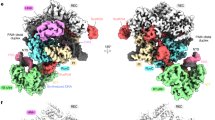Abstract
MANY viral and eukaryotic messenger RNAs have been shown to contain blocks of sequence which, although adjacent to one another in the RNA, are copied from non-contiguous regions of the genome that are joined together post-transcriptionally. This phenomenon of RNA splicing has been shown to occur during the processing of several DNA and RNA tumour viruses1–7 and cellular8–10 mRNAs. The mechanism by which splicing is carried out has not been elucidated, and any direct approach is complicated by the elaborate splicing patterns found in the systems which have been examined so far. We have extended these studies of RNA splicing to a potentially simpler viral system, the minute virus of mice (MVM), a non-defective member of the parvovirus group. The members of this group are considered to be among the simplest of the animal viruses, and comprise an icosahedral virion made from three structural protein species, containing one linear single-stranded DNA chromosome of ∼1.5 × 106 molecular weight (for review see ref. 11). The MVM DNA molecule contains a stable hairpin duplex at its 5′-end and a 3′-terminal structure suitable for priming complementary strand synthesis in vitro12,13. Little is known about the transcription process in parvo viruses. The only cytoplasmic mRNA species found for adeno-associated virus (AAV), a member of the defective subgroup, is a transcript of 70% of the genome which haS been shown by in vitro translation to code for the three capsid proteins14. The one study of transcription carried out in the non-defective subgroup has identified an analogous RNA species in Kilham rat virus (KRV)-infected cell cytoplasm which is complementary to 70% of the viral strand and sediments as a single component at about 18S (ref. 15). We report here our attempts to determine the sequence arrangement of MVM RNA by examining, in the electron microscope, hybrids formed between the abundant species of nuclear and cytoplasmic poly(A)+ RNA and single-stranded genomic DNA. We have found that about 30% of MVM RNA is spliced out following polyadenylation.
This is a preview of subscription content, access via your institution
Access options
Subscribe to this journal
Receive 51 print issues and online access
$199.00 per year
only $3.90 per issue
Buy this article
- Purchase on Springer Link
- Instant access to full article PDF
Prices may be subject to local taxes which are calculated during checkout
Similar content being viewed by others
References
Berget, S. M., Moore, C. & Sharp, P. A. Proc. natn. Acad. Sci. U.S.A. 74, 3171–3175 (1977).
Aloni, Y., Dhar, R., Laub, O., Horowitz, M. & Khoury, G. Proc. natn. Acad. Sci. U.S.A. 74, 3686–3690 (1977).
Chow, L. T., Gelinas, R. E., Broker, T. R. & Roberts, R. J. Cell 12, 1–8 (1977).
Klessig, D. F. Cell 12, 9–21 (1977).
Horowitz, M., Bratosin, S. & Aloni, Y. Nucleic Acids Res. 5, 4663–4675 (1978).
Panet, A., Gorecki, M., Bratosin, S. & Aloni, Y. Nucleic Acids Res. 5, 3219–3230 (1978).
Rothenberg, E., Donoghue, D. J. & Baltimore, D. Cell 13, 435–451 (1978).
Breathnach, R., Mandel, J. L. & Chambon, P. Nature 270, 314–319 (1977).
Tilghman, S. M., Curtis, P. J., Tiemeier, D. C., Leder, P. & Weissmann, C. Proc. natn. Acad. Sci. U.S.A. 75, 1309–1313 (1978).
Roop, D. R., Nordstrom, J. L., Tsai, S. Y., Tsai, M.-J. & O'Malley, B. W. Cell 15, 671–685 (1978).
Tattersall, P. in Replication of Mammalian Parvoviruses (eds Ward, D. C. & Tattersall, P.) 53–72 (Cold Spring Harbor Press, 1978).
Bourguignon, G. J., Tattersall, P. & Ward, D. C. J. Virol. 20, 290–306 (1976).
Chow, M. B. & Ward, D. C. in Replication of Mammalian Parvoviruses (eds Ward, D. C. & Tattersall, P.) 205–217 (Cold Spring Harbor Press, 1978).
Carter, B. J. in Replication of Mammalian Parvoviruses (eds Ward, D. C. & Tattersall, P.) 33–52 (Cold Spring Harbor Press, 1978).
Salzman, L. A. & Redler, B. J. Virol. 14, 434–440 (1974).
Tattersall, P., Shatkin, A. J. & Ward, D. C. J. molec. Biol. 111, 375–394 (1977).
Crawford, L. V. et al. Proc. natn. Acad. Sci. U.S.A. 75, 117–121 (1978).
Penman, S. J. molec. Biol. 17, 117–130 (1966).
Aloni, Y., Shani, M. & Reuveni, Y. Proc. natn. Acad. Sci. U.S.A. 72, 2587–2591 (1975).
Horowitz, M., Laub, O., Bratosin, S. & Aloni, Y. Nature 257, 558–559 (1978).
Canaani, D., Kahana, C., Mukamel, A. & Groner, Y. Proc. natn. Acad. Sci. U.S.A. (in the press).
Bratosin, S., Horowitz, M., Laub, O. & Aloni, Y. Cell 13, 783–790 (1978).
Author information
Authors and Affiliations
Rights and permissions
About this article
Cite this article
TAL, J., RON, D., TATTERSALL, P. et al. About 30% of minute virus of mice RNA is spliced out following polyadenylation. Nature 279, 649–651 (1979). https://doi.org/10.1038/279649a0
Received:
Accepted:
Issue Date:
DOI: https://doi.org/10.1038/279649a0
Comments
By submitting a comment you agree to abide by our Terms and Community Guidelines. If you find something abusive or that does not comply with our terms or guidelines please flag it as inappropriate.



